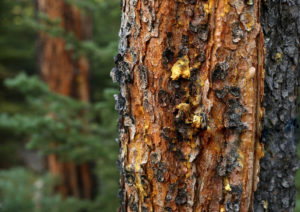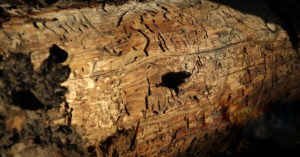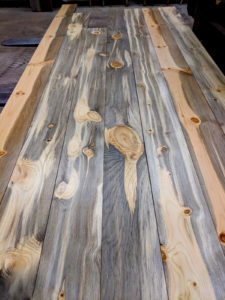What is Beetle Killed Blue Pine?
Posted: April 17, 2023Click here to purchase our Beetle Kill Pine flooring.
Click here to purchase our Beetle Kill Pine Wall and Ceiling Paneling.
 Author–Ryan Palma Owner/CEO Sustainable Lumber Co.
Author–Ryan Palma Owner/CEO Sustainable Lumber Co.
Montana’s pine beetles are small insects that created a huge infestation that greatly impacted our forests. These insects, which are only about the size of a grain of rice, are responsible for killing millions of acres of pine trees across North America. After the pine beetle’s infestation, they left behind a wake of destruction that can take decades to recover from. In this post, we’ll take a closer look at the impacts of their destruction, what beetle-killed pine is, why it’s a problem, and what can be done to mitigate its effects.
First, let’s define what beetle-killed pine is. When the Montana pine beetles infest a tree, they burrow into the bark and lay their eggs. The eggs hatch and the larvae begin feeding on the inner bark of the tree which in turn cuts off the tree’s ability to transport water and nutrients, ultimately killing the tree from the inside out. As the tree dies it turns a reddish brown in color prior to losing its needles, hence the term beetle-killed pine. 
The problem with beetle-killed pine is that it’s not just one tree that’s affected, entire forests can be devastated. The pine beetle is particularly attracted to mature, dense stands of trees, which makes them a major threat to our natural resources. When a pine beetle infestation occurs, it can spread rapidly, killing millions of trees in a matter of months.
The impact of the Montana’s pine beetle infestation goes beyond just the loss of trees. Dead and dying trees are more likely to catch fire, which can lead to devastating wildfires. They also provide a habitat for invasive species and can make it difficult for native plants and animals to thrive. In addition, the economic impact of beetle-killed pine can be significant, as the loss of timber can harm local economies that depend on the forest industry.
 So what can be done to mitigate the effects of beetle-killed pine? One solution is to thin out dense stands of trees, which makes it more difficult for the beetles to spread. For instance, the mountain pine beetle can only fly less than 300 feet. Another solution is to use pesticides, however, this can be controversial and may have unintended consequences. Additionally, it’s important to proactively monitor for and detect early signs of pine beetle infestations.
So what can be done to mitigate the effects of beetle-killed pine? One solution is to thin out dense stands of trees, which makes it more difficult for the beetles to spread. For instance, the mountain pine beetle can only fly less than 300 feet. Another solution is to use pesticides, however, this can be controversial and may have unintended consequences. Additionally, it’s important to proactively monitor for and detect early signs of pine beetle infestations.
 After these trees die it is important to harvest as many as possible while their wood fiber is still intact and usable. By utilizing salvaged timber like in our beetle-killed blue pine planks, we can sequester their carbon. Trees absorb carbon dioxide (CO2) from the atmosphere through the process of photosynthesis. When a tree is harvested for timber, the carbon stored in the tree is not released back into the atmosphere. Instead, it remains stored in the wood, which means if you can use these trees for lumber you are actively removing carbon from the atmosphere. It’s estimated that salvaged timber can store up to 1 ton of CO2 per 1000 square feet.
After these trees die it is important to harvest as many as possible while their wood fiber is still intact and usable. By utilizing salvaged timber like in our beetle-killed blue pine planks, we can sequester their carbon. Trees absorb carbon dioxide (CO2) from the atmosphere through the process of photosynthesis. When a tree is harvested for timber, the carbon stored in the tree is not released back into the atmosphere. Instead, it remains stored in the wood, which means if you can use these trees for lumber you are actively removing carbon from the atmosphere. It’s estimated that salvaged timber can store up to 1 ton of CO2 per 1000 square feet.
 To conclude, pine beetle infestations are a significant problem that can have a devasting impact on our forests and the communities that depend on them. While it may be difficult to eradicate the threat of pine beetles completely, there are steps that can be taken to mitigate their effects and protect our natural resources. By staying informed, taking action, and utilizing this dead timber, we can work together to preserve our forests for future generations.
To conclude, pine beetle infestations are a significant problem that can have a devasting impact on our forests and the communities that depend on them. While it may be difficult to eradicate the threat of pine beetles completely, there are steps that can be taken to mitigate their effects and protect our natural resources. By staying informed, taking action, and utilizing this dead timber, we can work together to preserve our forests for future generations.
Our knowledgeable and educated staff is here to answer any additional questions you may have. Please call us today for a free quote: Ph# 406.642.7120 or click here to submit an inquiry online. We look forward to working with you on your next project!

